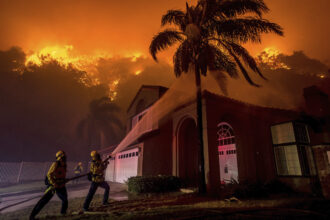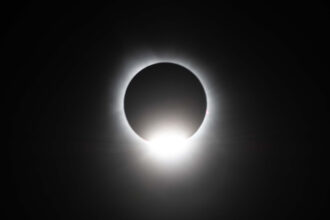Most of Puerto Rico remained in the dark Tuesday morning as crews rushed to assess and repair the damage caused by Hurricane Fiona, which continues to gather strength on its northwest path toward the Turks and Caicos Islands.
The U.S. territory suffered “catastrophic damage” over the weekend and through Monday, Gov. Pedro Pierluisi said, after the Category 1 storm unleashed violent winds and torrential rain, killing at least three people, forcing hundreds more to evacuate and knocking out power for more than a million homes and businesses.
Fiona, which made landfall on the southern shore of Puerto Rico on Sunday, is the year’s first major hurricane of the Atlantic season and the first storm of its strength to hit the territory since Hurricane Maria crippled the island’s electrical grid in 2017. It’s also the clearest example to date of the Puerto Rico government’s failure to adequately prepare for the increasingly frequent and destructive storms that scientists say are being exacerbated by climate change.
As of Tuesday morning, less than 150,000 of Puerto Rico’s 1.4 million public utility customers had working electricity, despite tens of billions of dollars in federal aid and a massive five-year effort to overhaul and modernize the island’s poorly maintained and unsound powergrid. But a growing number of Puerto Ricans, who have privately installed solar systems on the roofs of their homes and businesses, say the island-wide blackout caused by Fiona could have been entirely avoided, pointing to themselves as proof of a better way.
“We’re fine,” Arturo Massol-Deyá, who uses solar panels and battery storage to power his house, his office and several other buildings in Adjuntas, a mountainside town in central Puerto Rico, told me in an interview Monday afternoon. “Basically, we’re waiting for the sun to shine again—we don’t have damage, all the infrastructure is in place and it’s running. It was running during the hurricane.”
Eddie Ramirez, owner of Casa Sol, a bed and breakfast located in the territory’s northern capital of San Juan, gave a similar response. “Personally, me and my family, we’re good,” Ramirez, who equipped his business with solar panels and battery storage back in 2013, told me over the phone. “Puerto Rico, I can say, is not.”
In the southeastern coastal city of Salinas, which was in the center of Fiona’s path and likely saw some of the storm’s worst damage, environmental attorney Ruth Santiago said her solar system also kept her lights on throughout the storm. “That’s why I’m charging my phone and making lunch and that kind of thing, but no one else has power,” she told me, apologizing as the beep of a timer chirped in the background.
“Sorry,” she said, “that was just my oven going off.”
The same goes for a gas station in Utuado, a pharmacy in Patillas and a community center in Arecibo. All of them had installed solar panels and battery storage this summer and none lost power during the storm, a local familiar with the businesses told Inside Climate News.
While the full extent of Fiona’s damage to Puerto Rico remains to be seen, the six anecdotes highlight a growing frustration among Puerto Ricans, who don’t trust their government to provide them with reliable electricity, especially during natural disasters, and are increasingly turning to privately-installed rooftop solar systems to provide their energy needs.
Since 2017, more than 40,000 Puerto Rican households have installed, or are in the process of installing, rooftop solar panels, according to a report released last week by the Institute for Energy Economics and Financial Analysis, a progressive think tank that promotes renewable energy. The vast majority of those systems have been installed with battery storage, the report said, and currently provide 3.7 percent of the territory’s total electricity consumption, outpacing the island’s utility-scale projects.
But the report also criticizes the Puerto Rican government, which it says “continues its misguided push for natural gas” while building “no new renewable energy.”
Hurricane Maria made landfall in Puerto Rico in September 2017 as a Category 4 storm and is believed to have caused nearly 3,000 deaths on the island, many of which were due to a lack of electricity. In its aftermath, the residents of Puerto Rico demanded that their government transition away from expensive fossil fuel imports and toward renewable energy.
Energy analysts and climate activists have said that renewable power, when paired with battery storage and smaller electrical grids, is better suited to withstand the kinds of increasingly destructive storms the territory will face as the climate crisis worsens. Solar and wind energy circumvent the complications associated with importing fuels, they say, and smaller grids help to prevent widespread blackouts when a major power plant goes offline or a key transmission line goes down.
Puerto Ricans broadly agreed with that reasoning, and shortly after Maria, voters pressured their government to pass a law in 2019 that requires the island to be fully powered by solar, wind or other renewable sources by 2050. Additional regulations also require Puerto Rico to prioritize smaller, independent grids.
But progress on that effort has been slow, to say the least, and many residents, including Santiago, Ramirez and Massol-Deyá, say their government and public utility, as well as LUMA Energy—the private company that took over the island’s power transmission system last year—have failed to take the law seriously.
In fact, the two power companies, both of which have significant ties to global investment firms that specialize in fossil fuel infrastructure development and natural gas distribution, have been repeatedly accused by Puerto Rico’s top energy regulator and members of the U.S. Congress of “dragging their feet” when it comes to building new solar, wind and other renewable energy capacity on the island. The Puerto Rico Energy Bureau has even threatened the companies with fines if they didn’t plan for more renewable development and pick up the pace on securing it.
In March, Puerto Rico’s public utility reported that less than 5 percent of the island’s electricity was coming from renewable sources and warned that it would likely miss the first legal benchmark of obtaining 40 percent of the territory’s electricity from renewable sources by 2025. Widespread, daily blackouts, paired with quickly rising energy costs, have also angered many Puerto Ricans, who have called for their governor to resign and for the Puerto Rican government to end its contract with LUMA.
Both LUMA and Puerto Rico’s public utility have defended their track records, however, saying the public has painted an unfair picture of their efforts. “People are trying to portray us as anti-solar and it’s absolutely not true,” Wayne Stensby, LUMA Energy’s CEO, said at a Congressional hearing in October.
Most notably, LUMA pointed to the progress made processing a massive backlog of requests to connect private solar systems to Puerto Rico’s centralized electricity grid. The company has processed thousands of those requests in the matter of months, though many more remain.
In February, the Biden administration promised to help Puerto Rico achieve its renewable energy ambitions, saying it would align a record amount of federal aid Congress has earmarked to repair the territory’s tattered grid and boost its struggling economy with the goals of its landmark 2019 clean energy law.
But Santiago, who also sits on the White House Environmental Justice Advisory Council, which advises the Biden administration on ways to advance environmental justice, said she’s not convinced federal agencies are doing much to follow through on that commitment.
The Government Accountability Office said Thursday that Puerto Rico has spent only 2 percent of the $21 billion that the Federal Emergency Management Agency has approved for Maria-related recovery efforts. And the recovery money Puerto Rico has spent so far has gone toward rebuilding the island’s centralized grid, as well as bolstering and repairing the fossil fuel power plants that still produce the vast majority of the electricity, she said.
Most Puerto Ricans still can’t afford to install their own private solar systems, Santiago said, so they need help and the historic amount of federal aid going to Puerto Rico could make all the difference. The Puerto Rico government and the Biden administration “could change this whole situation around,” she said. “People don’t have to live like this, for days and weeks and—who knows—maybe months without power. Things could be totally different, it does not have to be this way at all.”
Thanks for reading Today’s Climate, and I’ll be back in your inbox on Friday.
Today’s Indicator
17 percent
If you add up all the money every Caribbean country makes in a year, that’s the average percentage that is lost because of the damages caused by storms, u003ca href=u0022https://www.undp.org/latin-america/after-rain-lasting-effects-storms-caribbeanu0022u003eaccording to the United Nationsu003c/au003e. Experts say that trend will only get worse as the planet warms.
Top News from Our Warming World
China Lost Its Yangtze River Dolphin. Climate Change Is Coming for Other Species Next – CNN
EU’s ‘Fake’ Green Label for Gas and Nuclear Are Under Legal Attack – Bloomberg
Tensions Rise Amid Frustration Over Mystery Manchin Deal – The Hill



















